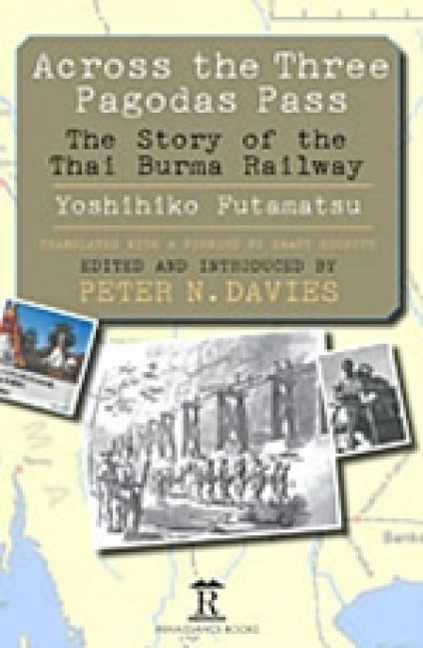Book contents
- Frontmatter
- Dedication
- Contents
- Acknowledgements
- Foreword
- Introduction
- Across the Three Pagodas Pass
- Translator’s Acknowledgements
- Preface
- Chapter 1 Departure for the Front
- Chapter 2 In Indo-China
- Chapter 3 Opening of Hostilities
- Chapter 4 The River Krian
- Chapter 5 The Malayan Campaign
- Chapter 6 The Fall of Singapore
- Chapter 7 Surrender
- Chapter 8 Shōnan: Light of the South
- Chapter 9 The Thai-Burma Railway
- Chapter 10 Preparing Construction
- Chapter 11 Banpong
- Chapter 12 Prisoners-of-War
- Chapter 13 Constructing the Railway
- Chapter 14 Thailand
- Chapter 15 The River Kwae Noi
- Chapter 16 The Mae Khlaung Bridge
- Chapter 17 Kanchanaburi
- Chapter 18 The Jungle
- Chapter 19 From Bangkok to Singapore
- Chapter 20 Rush Construction
- Chapter 21 The Base at Wanyai
- Chapter 22 The Labour Force
- Chapter 23 Survey Unit
- Chapter 24 Test Run
- Chapter 25 Bridge-Building and Shifting Earth
- Chapter 26 The Rainy Season: The Monsoon
- Chapter 27 Kinsaiyok
- Chapter 28 Diseases and Epidemics
- Chapter 29 Cattle Drive
- Chapter 30 Living in the Jungle
- Chapter 31 Soon to the Three Pagodas Pass
- Chapter 32 Towards the Setting Sun
- Chapter 33 Opening to Traffic
- Chapter 34 The Bombing
- Chapter 35 End of the War
- Chapter 36 Internment
- Chapter 37 Repatriation
- Footnote
- Postscript
- End Notes
- Glossary
- Bibliography
- Index
Chapter 9 - The Thai-Burma Railway
Published online by Cambridge University Press: 13 May 2022
- Frontmatter
- Dedication
- Contents
- Acknowledgements
- Foreword
- Introduction
- Across the Three Pagodas Pass
- Translator’s Acknowledgements
- Preface
- Chapter 1 Departure for the Front
- Chapter 2 In Indo-China
- Chapter 3 Opening of Hostilities
- Chapter 4 The River Krian
- Chapter 5 The Malayan Campaign
- Chapter 6 The Fall of Singapore
- Chapter 7 Surrender
- Chapter 8 Shōnan: Light of the South
- Chapter 9 The Thai-Burma Railway
- Chapter 10 Preparing Construction
- Chapter 11 Banpong
- Chapter 12 Prisoners-of-War
- Chapter 13 Constructing the Railway
- Chapter 14 Thailand
- Chapter 15 The River Kwae Noi
- Chapter 16 The Mae Khlaung Bridge
- Chapter 17 Kanchanaburi
- Chapter 18 The Jungle
- Chapter 19 From Bangkok to Singapore
- Chapter 20 Rush Construction
- Chapter 21 The Base at Wanyai
- Chapter 22 The Labour Force
- Chapter 23 Survey Unit
- Chapter 24 Test Run
- Chapter 25 Bridge-Building and Shifting Earth
- Chapter 26 The Rainy Season: The Monsoon
- Chapter 27 Kinsaiyok
- Chapter 28 Diseases and Epidemics
- Chapter 29 Cattle Drive
- Chapter 30 Living in the Jungle
- Chapter 31 Soon to the Three Pagodas Pass
- Chapter 32 Towards the Setting Sun
- Chapter 33 Opening to Traffic
- Chapter 34 The Bombing
- Chapter 35 End of the War
- Chapter 36 Internment
- Chapter 37 Repatriation
- Footnote
- Postscript
- End Notes
- Glossary
- Bibliography
- Index
Summary
In the Spring of 1942, with a pause after the occupation of Singapore, the campaign to occupy Burma went ahead. As Rangoon was the supply-base for Burma, for Southern Region Army GHQ there arose the urgent problem of the safety of the supply route by sea. In Burma the British-Indian Allied Forces had given in to the Japanese Army's offensive in a crushing defeat, but because of submarines from the British Western Fleet operating in the Andaman Sea off Burma the Japanese maritime supply-route was threatened, so the overland part of the preparations for the campaign to recapture Burma on the way to India was pressed forward. This year in June in the battle off Midway Island the Japanese Navy lost from its main force four aircraft-carriers sunk, a heavy blow which destroyed the hope of any defence in the Andaman Sea. The safety of transports out of Singapore to seas off Burma had become a problem. Southern Region Army used the plan for an overland route to Burma, taking advantage of the study made in 1939 at Daihonéi (Imperial Japanese Army HQ in Tokyo) to find what use could be made of a railway out of Thailand into Burma. In their survey, construction of a railway would need ‘two railway regiments taking about a year’. Major-General Hattori Shimpei, commanding Southern Region Army's 2 Railway Control, resolved in February this year to make a survey on the ground of this railway project. On receipt of his order, Staff Officer Irie, together with Railway Official Nishijima surveyed the area from Kanchanaburi up to the Three Pagodas Pass on the frontier. They judged that the volume of work needed was much greater than in the original estimate, and calculated that it would take over two years. It therefore became urgent for the construction to start promptly, so without waiting for Daihonéi's orders the General assigned in March 1942 the main construction units, namely 1 Railway Materials Workshops, 5 Railway Regiment, and 9 Railway Regiment.
- Type
- Chapter
- Information
- Across the Three Pagodas PassThe Story of the Thai-Burma Railway, pp. 34 - 40Publisher: Amsterdam University PressPrint publication year: 2013



